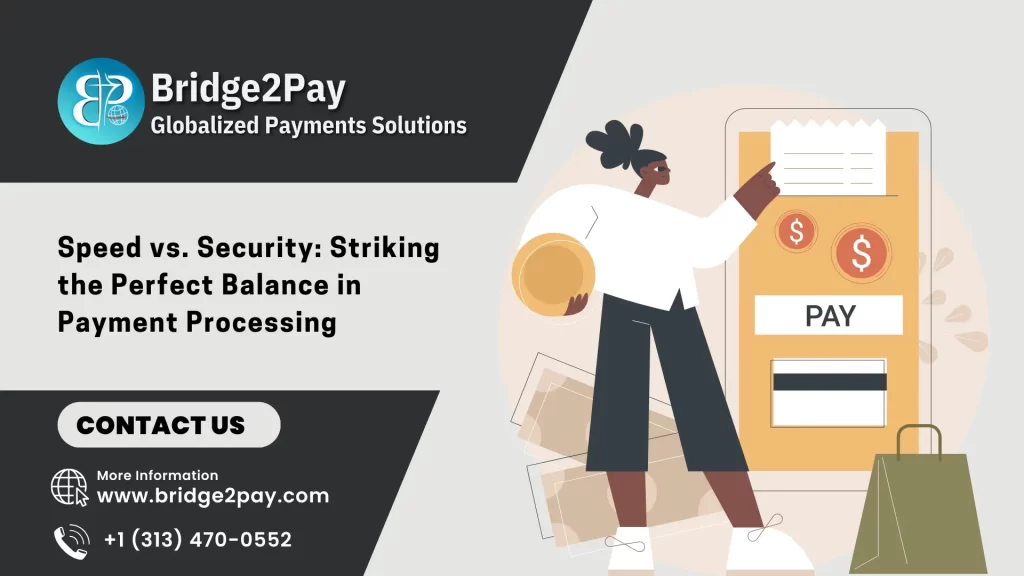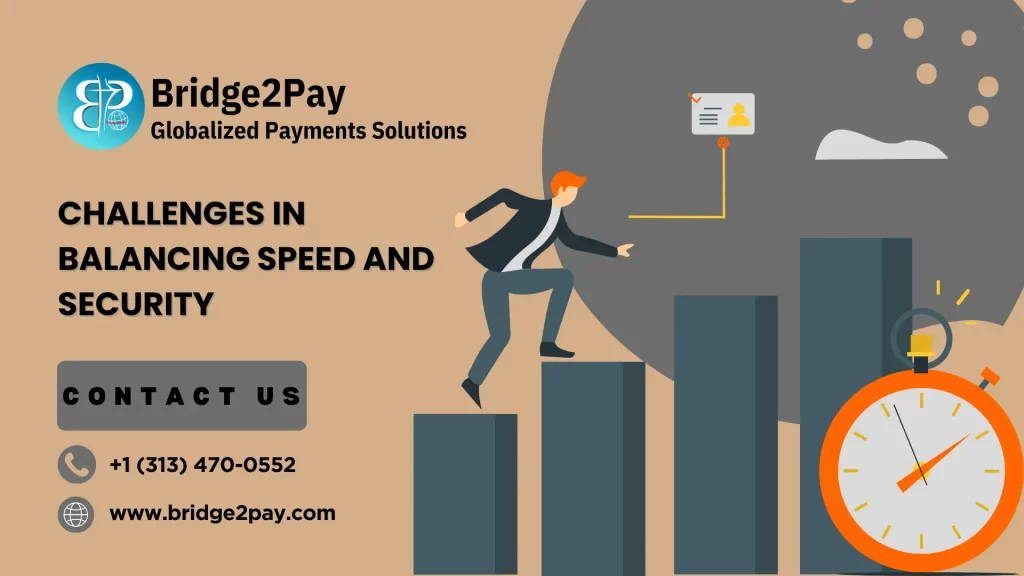
Introduction – B2P Payment Processing
In today’s rapidly evolving digital payment processing businesses and consumers alike expect fast, seamless transactions. However, as transaction speeds increase, security vulnerabilities also grow, making it imperative to find the optimal balance between efficiency and robust protection. This article delves into the complexities, solutions, and best practices for harmonizing speed and security in payment processing.
The Significance of Speed in Payment Processing

1. Enhancing Customer Satisfaction
- Swift transactions elevate user experience and encourage customer loyalty.
- Slow payment processing can result in abandoned carts and revenue loss.
- Research by the Baymard Institute shows that nearly 70% of online shopping carts are abandoned, with slow and complicated checkouts being a primary reason.
2. Streamlining Business Operations
- Expedited payments facilitate smooth operations and improved cash flow management.
- Reduces manual intervention, thereby lowering errors and operational costs.
- Businesses that offer faster transaction processing tend to experience greater customer retention and increased repeat purchases.
3. Gaining a Competitive Edge
- Companies with rapid checkout processes outperform their competitors.
- Payment speed is a critical factor in customer retention and conversion rates.
- In industries like e-commerce and gaming, even minor transaction delays can drive customers away.
The Crucial Role of Security in Payment Processing
1. Defending Against Fraud
- Cybercriminals frequently target payment systems to steal sensitive data.
- Robust security measures help safeguard businesses and consumers from fraudulent transactions.
- Digital payment fraud is predicted to cost businesses over $48 billion globally by 2023.
2. Meeting Regulatory Compliance Standards in Payment Processing
- Companies must adhere to industry regulations like PCI DSS, GDPR, and PSD2.
- Failing to comply can lead to legal repercussions, fines, and reputational damage.
- Regulatory bodies continually refine security requirements to counter emerging threats.
3. Building Consumer Trust and Brand Reputation
- A secure payment ecosystem fosters consumer confidence and enhances brand credibility.
- Data breaches can have long-term detrimental effects on a business’s reputation.
- Studies indicate that 79% of consumers would cease engagement with a brand following a data breach.
Challenges in Balancing Speed and Security in Payment Processing

1. Heightened Fraud Risks with Accelerated Transactions
- Real-time payments limit the time available for fraud detection mechanisms.
- Fraud detection systems must analyze transactions within milliseconds.
- Cybercriminals exploit weak points in rapid transaction approvals.
2. Complex Security Protocols Slowing Down Payments
- Multi-factor authentication can add friction to the user experience.
- Achieving the right balance between security and convenience is challenging.
- Inefficient authentication processes can lead to customer frustration and churn.
3. Ensuring Security Across Multiple Payment Channels
- Different payment methods require tailored security and speed optimizations.
- Maintaining seamless security across all platforms adds to operational complexity.
- Omnichannel payment processing presents an increased risk of security gaps.
Strategies for Achieving the Right Balance

1. Leveraging AI-Driven Fraud Prevention
- AI and machine learning assess transaction patterns in real time.
- Reduces dependency on manual intervention while enhancing fraud detection.
- AI-based systems lower false positives and improve overall security.
2. Implementing Tokenization and Encryption
- Tokenization substitutes sensitive payment data with unique tokens.
- Encryption ensures data remains secure during transmission.
- These technologies significantly mitigate the risk of data breaches.
3. Smart Utilization of Multi-Factor Authentication (MFA)
- Adaptive authentication enhances security without adding unnecessary friction.
- Risk-based authentication allows seamless processing for low-risk transactions.
- Combining biometric verification with MFA further strengthens security.
4. Optimizing Payment Gateways for Performance and Security
- Modern payment gateways deliver both speed and security.
- Cloud-based solutions and APIs enhance transaction efficiency.
- Choosing gateways with advanced fraud prevention mechanisms is critical.
5. Ensuring Ongoing Compliance with Industry Regulations
- Adhering to standards like PCI DSS, GDPR, and PSD2 ensures regulatory compliance.
- Compliance measures inherently enhance security and consumer trust.
- Staying updated on regulatory changes prevents future penalties.
6. Utilizing Blockchain for Secure and Efficient Transactions
- Blockchain technology ensures decentralized, tamper-proof transactions.
- Eliminates intermediaries, expediting secure payment processes.
- Smart contracts automate and enforce payment conditions effectively.
Case Studies: Companies Excelling in Balancing Speed and Security
1. PayPal
- Employs AI-powered fraud detection to ensure fast and secure payments.
- Uses risk-based authentication to minimize user inconvenience.
- Maintains rapid processing while adhering to PCI DSS compliance.
2. Stripe
- Implements tokenization to safeguard payment details.
- Utilizes high-level encryption to protect consumer data.
- Offers seamless business integration without compromising security.
3. Square
- Delivers a frictionless checkout process while ensuring compliance.
- Uses machine learning algorithms for real-time fraud detection.
- Provides biometric authentication options to enhance security.
Future Developments in Payment Processing
1. Biometric Authentication
- Fingerprint and facial recognition enhance security without slowing transactions.
- Expected to become a mainstream authentication method for online and offline payments.
- Businesses increasingly integrate biometric authentication to minimize fraud risks.
2. Real-Time Payments (RTP) with Enhanced Security
- RTP platforms like UPI, FedNow, and SEPA Instant Payments are gaining momentum.
- AI-driven fraud detection will continue evolving alongside RTP solutions.
- Instant settlements reduce the likelihood of chargeback fraud.
3. Zero Trust Security Frameworks
- Zero Trust models require continuous user authentication to prevent breaches.
- Enhances security while ensuring seamless payment experiences.
- Eliminates implicit trust, making unauthorized access more difficult.
4. Merging AI and Blockchain for Superior Security
- AI-powered fraud detection combined with blockchain transparency fortifies security.
- Smart contracts enable automated, tamper-resistant transactions.
- Decentralized identity solutions bolster data security and transaction integrity.
Future Developments in Payment Processing
1. Biometric Authentication: Enhancing Security and Convenience
Biometric authentication, including fingerprint scanning, facial recognition, and iris scanning, is transforming payment processing by improving security and user experience. This technology eliminates the need for passwords and PINs, reducing fraud risks while maintaining transaction efficiency. As biometric capabilities become integrated into smartphones, wearables, and payment terminals, their adoption in both online and offline transactions is growing rapidly. Businesses are embracing biometric authentication to enhance security, improve compliance, and offer seamless transactions.
Beyond traditional biometric methods, innovations such as voice recognition and palm vein authentication add extra layers of protection. With AI-driven fraud detection, these methods make unauthorized transactions significantly harder. The global biometric payments market is expanding, fueled by advancements in sensor technology and AI-powered identity verification.
2. Real-Time Payments (RTP) with Advanced Security Measures
Real-time payment processing systems, including India’s UPI, the U.S. FedNow, and Europe’s SEPA Instant Payments, are revolutionizing transactions by enabling immediate fund transfers. These platforms enhance user convenience and improve business cash flow while necessitating advanced security measures to prevent fraud.
AI-driven fraud detection is evolving alongside RTP, leveraging machine learning to analyze transaction patterns and detect anomalies in real time. Payment processors and financial institutions are investing in predictive analytics to mitigate risks before fraudulent activity occurs. Additionally, regulatory bodies are enforcing security protocols such as encryption and tokenization to protect transactions.
Instant settlements minimize chargeback fraud, eliminating the delay that fraudsters exploit in traditional payment systems. As real-time transactions become the standard, the financial sector is focusing on refining security measures to safeguard users.
3. Zero Trust Security Models: A Proactive Defense Strategy
The Zero Trust security model is gaining prominence in payment processing due to evolving cyber threats. Unlike conventional frameworks that assume network trust, Zero Trust mandates continuous authentication and verification, significantly strengthening security while maintaining smooth transactions.
This approach relies on multi-factor authentication (MFA), strict access controls, and real-time monitoring to prevent security breaches. Organizations adopting Zero Trust frameworks eliminate implicit trust, making it significantly harder for cybercriminals to infiltrate networks. Given the rise of digital payments, this model is critical for protecting financial data from cyber threats like phishing attacks and identity theft.
With cloud-based payment platforms and remote transactions becoming the norm, Zero Trust is a key strategy for reducing risks. AI-driven threat detection and behavioral analytics ensure that only legitimate transactions are processed.
4. AI and Blockchain: Strengthening Payment Security
The convergence of AI and blockchain technology is transforming payment processing by offering transparency and fraud resilience. AI-driven fraud detection utilizes deep learning to analyze vast transaction datasets, identifying irregularities with high precision. By learning from evolving patterns, AI enhances fraud prevention and minimizes false positives.
Blockchain’s decentralized nature ensures that payment records remain tamper-proof. Transactions recorded on a blockchain are immutable, reducing the risk of fraud. Smart contracts further enhance security by automating payments based on pre-set conditions, eliminating human intervention.
Decentralized identity solutions built on blockchain are also emerging, giving users more control over personal data while reducing identity theft risks. As AI and blockchain continue evolving, their integration will further enhance transaction security and data protection.
Emerging Technologies Shaping Payment Security
1. Quantum Computing and Next-Generation Cryptography
Quantum computing introduces both opportunities and security challenges in payment processing. While quantum computers can solve complex computations at extraordinary speeds, they also threaten traditional encryption methods. Current cryptographic protocols, such as RSA and ECC, could become vulnerable to quantum-powered attacks.
Post-quantum cryptography is being developed to counteract these threats, ensuring digital transactions remain secure. Governments, financial institutions, and tech companies are working together to establish encryption standards that can resist quantum computing threats. Businesses should prepare for the shift toward quantum-safe security measures to protect financial data.
2. AI-Driven Digital Identity Verification
Digital identity verification plays a key role in securing payment processing, and AI is enhancing its accuracy and efficiency. AI-powered systems authenticate users by analyzing biometric data, behavioral patterns, and document authenticity in real time. This not only reduces fraud risks but also streamlines user authentication.
Biometric verification methods, including facial and fingerprint recognition, ensure that only authorized users access financial services. Governments and financial institutions are widely adopting digital ID solutions to enhance security and regulatory compliance. With AI-driven improvements, digital identity verification is becoming more sophisticated, further strengthening payment security.
3. 5G’s Influence on Transaction Speed and Security
The deployment of 5G technology is transforming payment processing, enabling ultra-fast transactions and enhanced security. With reduced latency and high-speed data transfers, 5G networks facilitate nearly instantaneous payments, optimizing user experience in digital and mobile platforms.
5G networks also implement advanced security features, such as enhanced encryption and network slicing, which minimize mobile transaction risks. To capitalize on 5G’s benefits, businesses must adapt their payment infrastructure to leverage its capabilities while maintaining robust security measures.
4. Embedded Finance and Seamless Payments
Embedded finance is reshaping consumer interactions with payment processing by integrating financial functions into non-financial platforms. This allows users to make payments directly within apps, social media, and smart devices, reducing reliance on traditional banking channels.
Invisible payments, powered by AI and NFC technology, eliminate the need for manual payment input. Examples include Amazon Go stores, where customers can pick up products and leave without checkout, as payments are processed automatically. As these trends grow, security solutions must evolve to prevent fraud and protect consumer data.
5. Decentralized Finance (DeFi) and Its Payment Implications
Decentralized Finance (DeFi) is redefining financial systems by enabling peer-to-peer transactions without intermediaries. Built on blockchain, DeFi platforms offer secure, transparent, and decentralized payment processing solutions. Smart contracts enable automated transactions, reducing reliance on banks and payment processors.
Despite its advantages, DeFi faces security challenges, including vulnerabilities in smart contracts and regulatory uncertainties. As adoption increases, addressing these challenges will require robust security protocols and compliance measures. The future of payments will likely involve collaboration between traditional financial institutions and DeFi platforms to create secure and efficient solutions.
Best Practices for Businesses
1. Educate Consumers on Secure Payment Practices
- Provide guidance on identifying phishing scams and fraudulent activities.
- Encourage strong passwords and multi-factor authentication.
- Keep customers informed about evolving security threats.
2. Conduct Routine Security Audits and System Updates
- Regular penetration testing helps detect vulnerabilities.
- Updating payment software ensures protection against emerging threats.
- Collaborate with security professionals to enhance the payment infrastructure.
3. Offer a Range of Secure Payment Options
- Provide encrypted digital wallets, credit card transactions, and bank transfers.
- Enable customers to select security-enhanced payment methods.
- Ensure instant payment confirmations for improved transparency and trust.
4. Monitor Transactions in Real-Time
- Use AI-driven automated systems for real-time anomaly detection.
- Implement alert mechanisms for suspicious transactions.
- Continuously refine fraud detection algorithms for accuracy.
Conclusion
Speed and security in payment processing are not mutually exclusive. By integrating AI, encryption, biometric authentication, and regulatory compliance, businesses can deliver both swift and secure transactions. Striking the right balance fosters customer trust, satisfaction, and long-term success. As digital payment technology advances, future innovations will further refine transaction efficiency and security.
Organizations that effectively balance speed and security will continue to thrive in the digital economy. Through proactive strategies and the adoption of emerging technologies, payment processing can be optimized for both performance and protection, ensuring a seamless experience for all stakeholders.